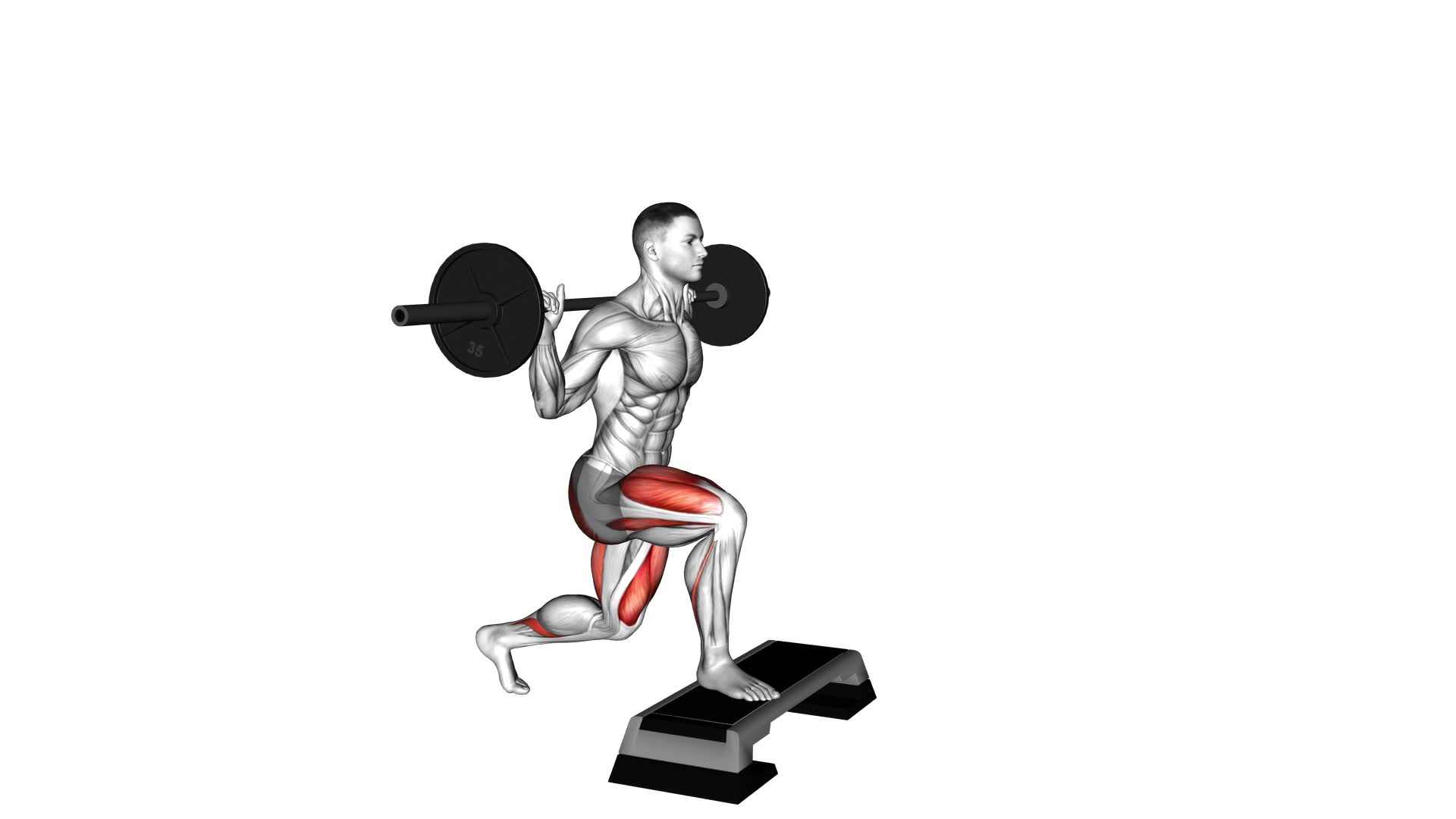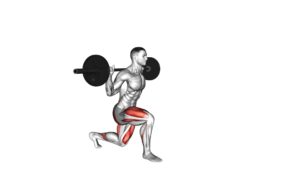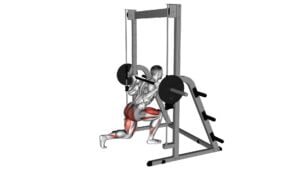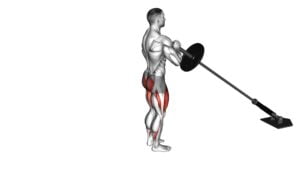Barbell Rear Lunge (VERSION 2) – Video Exercise Guide & Tips

Are you looking to level up your leg workout? Look no further than the barbell rear lunge (version 2). This exercise targets your glutes, quads, and hamstrings, giving you a powerful lower body workout.
Watch This Exercise Video
In this video exercise guide, we'll show you the proper form, common mistakes to avoid, and helpful tips for maximizing the effectiveness of the barbell rear lunge.
Get ready to take your leg day to the next level with this challenging and rewarding exercise.
Key Takeaways
- Barbell rear lunges improve balance, coordination, and overall lower body strength and aesthetics.
- Proper form includes starting with feet hip-width apart, maintaining good posture, and engaging the glutes, quads, and hamstrings during the lunge.
- Common mistakes to avoid include allowing the front knee to extend past the toes, leaning too far forward, and rushing through the movement.
- Progressions for barbell rear lunges include overhead rear lunges, Bulgarian split squats with a barbell, and barbell walking lunges for added intensity and variety.
Benefits of Barbell Rear Lunges
In this article, you'll discover the benefits of performing barbell rear lunges. Barbell rear lunges are a highly effective exercise that can provide numerous benefits for your fitness routine.
One of the key benefits is improved balance. By performing this exercise, you challenge your stability and engage your core muscles to maintain proper form throughout the movement. This can help you develop better balance and coordination, which is essential for everyday activities and sports performance.
Additionally, barbell rear lunges are excellent for muscle activation. This exercise primarily targets the muscles in your lower body, including your quadriceps, hamstrings, glutes, and calves. By incorporating barbell rear lunges into your workout routine, you can effectively strengthen and tone these muscles, leading to improved lower body strength and aesthetics.
In order to maximize the benefits of barbell rear lunges, it's important to perform them with proper form. Transitioning into the subsequent section about 'proper form for barbell rear lunges', we'll provide you with step-by-step instructions on how to execute this exercise correctly. Remember, proper form is crucial to prevent injuries and ensure maximum muscle activation.
Proper Form for Barbell Rear Lunges
To perform barbell rear lunges with proper form, you should focus on maintaining a stable core and engaging your lower body muscles. Here are three key tips to help you achieve the correct form:
- Start with the right stance: Stand with your feet hip-width apart and the barbell resting on your upper back. Take a step back with one foot, ensuring that both knees are slightly bent.
- Keep your upper body stable: Throughout the movement, maintain a straight posture, with your chest lifted and shoulders back. Avoid leaning forward or rounding your back, as this can put unnecessary strain on your spine.
- Focus on your lower body muscles: As you lower your body into the lunge, make sure to engage your glutes, quadriceps, and hamstrings. Keep your front knee in line with your toes, and aim to lower your back knee until it hovers just above the ground.
Now that you know the proper form for barbell rear lunges, let's discuss some common mistakes, as well as variations and modifications you can try to challenge yourself or accommodate any limitations you may have.
Common Mistakes to Avoid During Barbell Rear Lunges
When performing barbell rear lunges, it's important to be aware of common mistakes that should be avoided to maintain proper form and prevent injury.
One common mistake is allowing the front knee to extend past the toes. This can put excessive strain on the knee joint and increase the risk of injury. To avoid this, focus on keeping the front knee directly above the ankle throughout the movement.
Another common mistake is leaning too far forward. This can shift the weight onto the toes and strain the lower back. To maintain proper form, keep your chest up and your back straight throughout the lunge.
It's also important to avoid rushing through the movement. Taking small, controlled steps and maintaining a slow and controlled pace will help engage the muscles properly and prevent unnecessary strain.
Lastly, avoid locking out the knees at the top of the movement. This can cause unnecessary stress on the joint. Instead, keep a slight bend in the knees at all times to maintain stability and protect the knees.
Progressions for Barbell Rear Lunges
To progress your barbell rear lunges, you can incorporate additional weight or increase the range of motion. Here are three advanced variations and equipment options you can try:
- Barbell Overhead Rear Lunges: Hold the barbell overhead with your arms fully extended. This variation not only challenges your lower body but also engages your core and upper body muscles.
- Bulgarian Split Squats with Barbell: Elevate one foot behind you on a bench or a step, and hold the barbell across your upper back. This exercise targets your glutes, hamstrings, and quadriceps while also improving stability and balance.
- Barbell Walking Lunges: Hold the barbell across your upper back and perform walking lunges. This variation adds an element of dynamic movement, increasing the intensity and engaging more muscles throughout your body.
When it comes to equipment options, you can use a traditional barbell for these exercises. However, if you prefer a different challenge, you can try using a safety squat bar or a dumbbell in each hand. These alternatives can provide a different stimulus to your muscles and help you continue progressing in your barbell rear lunges.
Tips for Maximizing the Effectiveness of Barbell Rear Lunges
Are you wondering how to maximize the effectiveness of your barbell rear lunges? Here are some tips to help you get the most out of this exercise.
- First, consider adding resistance to your rear lunges. You can do this by using a barbell instead of just your body weight. This will challenge your muscles even more and help you build strength and endurance. Start with a weight that's challenging but still allows you to maintain proper form. As you progress, you can gradually increase the weight.
- Another way to maximize the effectiveness of your barbell rear lunges is by incorporating different variations. This will target different muscles and keep your workouts interesting. You can try doing walking lunges with the barbell on your back, or even perform a reverse lunge with a barbell overhead. These variations will engage your muscles in different ways and help you achieve a well-rounded lower body workout.
- Remember to always maintain proper form when performing barbell rear lunges. Keep your chest lifted, core engaged, and make sure your front knee stays in line with your ankle. Take your time with each rep and focus on the mind-muscle connection.
Frequently Asked Questions
How Much Weight Should I Use When Performing Barbell Rear Lunges?
When performing barbell rear lunges, the amount of weight you should use depends on your fitness level and goals. It's recommended to start with a weight that challenges you but allows you to maintain proper form. You can gradually increase the weight as you get stronger.
Additionally, there are variations of barbell rear lunges that can be done with different weights, such as using dumbbells or kettlebells. Experiment with different weights to find what works best for you.
Can Barbell Rear Lunges Help Improve My Balance and Stability?
Barbell rear lunges can definitely improve your balance and stability. By engaging multiple muscle groups, such as your quadriceps, glutes, and hamstrings, these lunges challenge your body's ability to maintain stability.
The added resistance from the barbell increases the demand on your muscles, leading to greater stability gains. Incorporating barbell rear lunges into your workout routine can help you develop better balance and overall stability, enhancing your performance in various activities.
Should I Perform Barbell Rear Lunges Before or After Other Leg Exercises in My Workout?
Performing barbell rear lunges as a warm-up for leg exercises can be beneficial. It helps activate the muscles in your legs and prepares them for the upcoming workout.
Additionally, adding barbell rear lunges to your leg day routine can enhance your strength, balance, and stability. By performing them before other leg exercises, you can maximize the benefits and improve your overall performance.
Incorporating this exercise into your routine can contribute to a well-rounded leg workout.
Are Barbell Rear Lunges Suitable for Beginners or Should I Have Some Prior Experience With Lunges?
Barbell rear lunges are suitable for beginners, but having prior experience with lunges can be helpful. These lunges are a great exercise to strengthen your legs and glutes. When performing the exercise, make sure to maintain proper form and avoid common mistakes like leaning too far forward or allowing your knee to extend past your toes.
There are also variations of the barbell rear lunge that you can try to add variety to your workout routine.
Can Barbell Rear Lunges Help With Strengthening My Glutes and Hamstrings?
Barbell rear lunges can definitely help strengthen your glutes and hamstrings. By incorporating the barbell into the exercise, you increase the resistance, making it more challenging and effective.
This exercise is great for glute activation, which can improve your overall sports performance. The benefits of barbell rear lunges in sports performance include enhanced power, stability, and lower body strength.
Conclusion
In conclusion, the barbell rear lunge is a highly effective exercise for strengthening and toning the lower body.
By maintaining proper form and avoiding common mistakes, you can maximize the effectiveness of this exercise.
Additionally, incorporating progressions and following the provided tips can help you achieve even better results.
So, make sure to include barbell rear lunges in your workout routine for improved leg strength and stability.

Author
Years ago, the spark of my life’s passion ignited in my mind the moment I stepped into the local gym for the first time. The inaugural bead of perspiration, the initial endeavor, the very first surge of endorphins, and a sense of pride that washed over me post-workout marked the beginning of my deep-seated interest in strength sports, fitness, and sports nutrition. This very curiosity blossomed rapidly into a profound fascination, propelling me to earn a Master’s degree in Physical Education from the Academy of Physical Education in Krakow, followed by a Sports Manager diploma from the Jagiellonian University. My journey of growth led me to gain more specialized qualifications, such as being a certified personal trainer with a focus on sports dietetics, a lifeguard, and an instructor for wellness and corrective gymnastics. Theoretical knowledge paired seamlessly with practical experience, reinforcing my belief that the transformation of individuals under my guidance was also a reflection of my personal growth. This belief holds true even today. Each day, I strive to push the boundaries and explore new realms. These realms gently elevate me to greater heights. The unique combination of passion for my field and the continuous quest for growth fuels my drive to break new ground.







